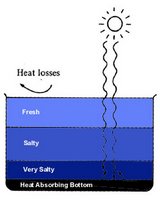Making Solar Energy More Usable

The rate of solar energy intercepted by the earth is about 5,000 times greater than the sum of all other energy sources, but less than 0.5 percent is represented in the kinetic energy of the wind, waves and in photosyntheticstorage in plants. The amount of the solar energyintercepted by earth is only one thousandth of one millionof the total released energy in the sun. Source.
One of the main problems with harvesting solar power on earth, is the limited number of hours per day that sunlight reaches the surface. Using photovoltaics, you are limited to an average of six hours per day of usable energy production, minus time for bad weather. Often the periods of heaviest usage of energy are times that the sun does not shine.
One way around that problem is to place photovoltaic panels in earth orbit, well above the shadow of the earth. Generated power can be beamed to earth by microwave, and collected by large rectenna farms on the surface. Here is a link to a blog, Power From Space, devoted to this topic.
Another method is to collect the sun's energy while it shines, and store the energy for later use. This method does not collect nearly as much energy as the orbiting solar satellites, but the sun provides so much extra energy to earth that it will suffice. What is the best method of storing solar energy?
Batteries are no good, because the energy density of batteries is too low, given their cost and short lifetimes. The only possible exception in terms of current battery technology would be redox flow cells. In five or ten years, redox flow cells might be ready for the challenge.
Electricity is hard to store at the present time. But energy comes in many forms, and is convertible from one form to another. I would like to suggest that with present technologies, the best form of solar energy storage is thermal storage--heat. Below are several links providing more information about thermal storage. In future posts, I will provide more detail regarding current efforts to utilise this important energy storage method.
Wiki
Purdue
Open Directory Thermal Energy Links
Ionic Thermal Storage
Dissertation on Phase-Change Heat Storage Systems
Thermal storage is a type of energy averaging. Rather than being forced to use all the six hours of sunlight at one time, the energy can be used over the entire 24 hour period. Solar Ponds are one form of thermal storage. OTEC is another, and in that sense the ocean itself could be thought of as a huge thermal system.
Humans need heating and cooling, and in that sense thermal storage will always be useful for human buildings and infrastructure. Eventually, for electric power purposes, redox flow cells and other newer electrical storage methods will eliminate the need for thermal-electric conversion losses.
Labels: electric storage battery, flow cells, heat storage, phase change

0 Comments:
Post a Comment
Subscribe to Post Comments [Atom]
<< Home